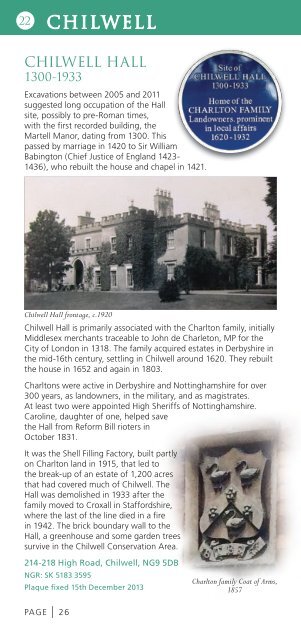GUIDE TO THE BLUE PLAQUES
BP%20final%20proof.2016.05.03
BP%20final%20proof.2016.05.03
Create successful ePaper yourself
Turn your PDF publications into a flip-book with our unique Google optimized e-Paper software.
22 CHILWELL<br />
CHILWELL 23<br />
CHILWELL HALL<br />
1300-1933<br />
Excavations between 2005 and 2011<br />
suggested long occupation of the Hall<br />
site, possibly to pre-Roman times,<br />
with the first recorded building, the<br />
Martell Manor, dating from 1300. This<br />
passed by marriage in 1420 to Sir William<br />
Babington (Chief Justice of England 1423-<br />
1436), who rebuilt the house and chapel in 1421.<br />
Chilwell Hall frontage, c.1920<br />
Chilwell Hall is primarily associated with the Charlton family, initially<br />
Middlesex merchants traceable to John de Charleton, MP for the<br />
City of London in 1318. The family acquired estates in Derbyshire in<br />
the mid-16th century, settling in Chilwell around 1620. They rebuilt<br />
the house in 1652 and again in 1803.<br />
Charltons were active in Derbyshire and Nottinghamshire for over<br />
300 years, as landowners, in the military, and as magistrates.<br />
At least two were appointed High Sheriffs of Nottinghamshire.<br />
Caroline, daughter of one, helped save<br />
the Hall from Reform Bill rioters in<br />
October 1831.<br />
It was the Shell Filling Factory, built partly<br />
on Charlton land in 1915, that led to<br />
the break-up of an estate of 1,200 acres<br />
that had covered much of Chilwell. The<br />
Hall was demolished in 1933 after the<br />
family moved to Croxall in Staffordshire,<br />
where the last of the line died in a fire<br />
in 1942. The brick boundary wall to the<br />
Hall, a greenhouse and some garden trees<br />
survive in the Chilwell Conservation Area.<br />
214-218 High Road, Chilwell, NG9 5DB<br />
NGR: SK 5183 3595<br />
Plaque fixed 15th December 2013<br />
PAGE | 26<br />
Charlton family Coat of Arms,<br />
1857<br />
GREGORY’S ROSES<br />
Gregory’s Roses placed Chilwell firmly on<br />
the world map in the 1950s, 60s and 70s.<br />
Charles Gregory (1867-1940), a<br />
nurseryman and florist specialising in<br />
roses, first started trading at the Old Close<br />
Nurseries on High Road, Chilwell and later in<br />
both Chilwell and Stapleford. His son Charles<br />
Walter Gregory (1908-1980) joined the firm in the<br />
mid-1920s, taking over after his father’s death in 1940. Both were<br />
active and well respected in the community.<br />
The nurseries built<br />
up a national and<br />
international reputation<br />
for their quality Chilwell<br />
Mark roses. Gregory’s<br />
received many awards<br />
over the years,<br />
cultivating popular<br />
new rose varieties and<br />
exhibiting regularly<br />
at the Chelsea Flower<br />
Show and many other<br />
shows throughout the<br />
country. In the 1960s Gregory’s Roses was one of Britain’s top three<br />
rose growers with the largest rose fields in the land. Both nurseries<br />
continued in parallel until Old Close was sold in the 1960s.<br />
The plaque is mounted on the<br />
former offices of Gregory’s<br />
Roses, originally the premises<br />
of The Old Sick Club, a friendly<br />
society established in 1771.<br />
Local historian Robert Mellors,<br />
writing in 1920, believed<br />
the building to date from<br />
1812; it is within the Chilwell<br />
Conservation Area.<br />
307 High Road,<br />
Chilwell, NG9 5DL<br />
NGR: SK 5162 3580<br />
Plaque unveiled 16th February<br />
2013<br />
Charles and Walter Gregory,<br />
courtesy of Rosemary McCarthy<br />
Advertisement, 1951,<br />
courtesy of Rosemary McCarthy<br />
PAGE | 27


